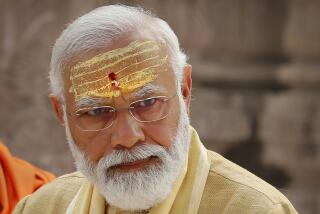Schiavo Was Beyond Saving, Autopsy Finds
During Terri Schiavo’s final days, when her fervent supporters said she was alert, responsive and trying to speak, she was massively and irreversibly brain-damaged, blind and oblivious to what surrounded her, a medical examiner’s findings revealed Wednesday.
Schiavo died March 31 at a Pinellas Park, Fla., hospice after the plastic tube through which she had received food and water for 15 years was removed by a Florida judge’s order, sought by her husband, who contended that she was in a persistent vegetative state.
Schiavo died of dehydration, said Dr. Jon R. Thogmartin, the chief medical examiner for Pinellas and Pasco counties, who announced the results of the autopsy at a news conference in Largo, Fla.
A battle over whether the Florida woman should be allowed to die had raged in Congress, the Florida Legislature and the state and federal courts, and President Bush signed a special law meant to help Schiavo’s parents keep her alive.
Although experts said the findings upheld the medical consensus on Schiavo’s condition, some opponents continued to object to the removal of her feeding tube. Senior Republican leaders, who had mobilized in vain to save Schiavo, had little reaction.
The parents, Bob and Mary Schindler of Gulfport, Fla., had contended their 41-year-old daughter could get better with care. But Thogmartin said the postmortem examination had shown an improvement would have been medically impossible, with her brain shrunken to less than half its normal size.
“The brain weighed 615 grams [about 1.36 pounds], roughly half of the expected weight of a human brain,” Thogmartin said. “This damage was irreversible, and no amount of therapy or treatment would have regenerated the massive loss of neurons.”
Although the Schindlers had wanted to feed their daughter by mouth, the medical examiner said Schiavo never would have been able to eat or drink on her own. Thogmartin also said the incapacitated woman could not see “because the vision centers of her brain were dead.”
The autopsy also found no evidence that Schiavo had been strangled, administered inappropriate medication or otherwise abused at the hands of her husband, Michael Schiavo.
In a lawsuit, Terri Schiavo’s parents had alleged that their son-in-law had wanted their daughter dead for reasons of financial gain.
Terri Schiavo had a heart attack and collapsed in her home Feb. 25, 1990. Her breathing stopped for several minutes, resulting in brain damage. Afterward, she was able to breathe unassisted but could not speak, eat or drink. Michael Schiavo, a Clearwater, Fla., nurse, had maintained that his wife would not have wished to be kept alive in such a state, and the courts sided with him.
Thogmartin also said that if her feeding tube had remained connected, and ailments common to bedridden patients, such as pneumonia and urinary tract infections, had been properly tended to, she might have lived another 10 years. The finding that Schiavo had been under no threat of imminent demise was seized upon by advocates for her parents as proof that her death was unnecessary, as well as immoral.
The autopsy report was the result of 274 X-rays and photographs, the analysis of dissected tissue samples, a review of Schiavo’s medical records, and reports from law enforcement and social service agencies. Its publication had been expected last month but it was delayed for a neuropathology report by an outside expert.
Independent medical specialists said the report should put to rest any lingering doubts that Schiavo was conscious when her feeding tube was disconnected March 18. They said they concurred that Thogmartin’s findings were in line with the prevailing consensus among neurologists that Schiavo had fallen into a persistent vegetative state brought on by lack of oxygen, causing brain cells to die. Although the primitive parts of the brain that regulate breathing and sleeping continue to function, such patients lose their ability to interact with the world.
However, they do make random movements, which are often misinterpreted by family members as signs that the patients are responding to them, neurologists said.
That diagnosis was, and still is, bitterly contested by the Schindlers. For patients in such a state, chances for improvement are considered nil.
“I personally cannot imagine that there could be consciousness in that brain,” said Dr. Martin A. Samuels, neurology department chairman at Brigham and Women’s Hospital in Boston. “People can be assured that no matter what anybody had done, it would not have helped. There are just no neurons.”
Michael Schiavo’s lawyer hailed Thogmartin’s report as supporting his client’s contention that Terri Schiavo had no real hope of recovery, and said Michael Schiavo planned to release autopsy photographs of his wife’s brain to prove how severe the damage was.
“Mr. Schiavo has received so much criticism throughout this case that I’m certain there’s a part of him that was pleased to hear these results and the hard science behind them,” George J. Felos told reporters outside his law offices in Dunedin, Fla.
In Washington, lawmakers who had pushed for Congress to intervene in the case had little to say about the autopsy.
A spokesman for House Majority Leader Tom DeLay (R-Texas) said only: “Congressman DeLay’s thoughts and prayers remain with the friends and family of Terri Schiavo.”
DeLay was criticized for remarks that federal judges would have “to answer for their behavior” in the Schiavo case. He later apologized.
A spokesman for Sen. Bill Frist (R-Tenn.) said the Senate majority leader had no comment. Frist, who is a physician, had disagreed with Schiavo’s diagnosis.
At the White House, Press Secretary Scott McClellan said the autopsy results did not change the president’s position that Schiavo’s source of nutrition and hydration should not have been removed.
“Our thoughts and prayers remain with her family and friends,” McClellan said. “The president was deeply saddened by this case.”
The medical examiner’s report did not resolve all of the mysteries surrounding what, during a seven-year odyssey through the Florida and federal court systems, became the most litigated right-to-die case in American history.
Thogmartin said he had been unable to verify that an eating disorder had led to her collapse. The low levels of potassium found then in her blood -- often a sign of an eating disorder -- could have had other medical explanations, Thogmartin said. Because of the uncertainties surrounding her collapse, the medical examiner listed the manner of death as “undetermined.”
“Their report shows what we have said -- that Terri was not terminal,” said the Schindlers’ lawyer, David C. Gibbs III, according to CNN. “Terri Schiavo was not in an end-of-life situation. The decision was made to end her life, and we believe it was done in a barbaric manner.”
Moreover, Gibbs said, Thogmartin’s report left some troubling questions unanswered, including what the Seminole, Fla., lawyer said was a 70-minute gap between the time Michael Schiavo reported that his wife collapsed in 1990, and when he telephoned 911 for help.
The Schindlers were traveling Wednesday to Minnesota and could not be reached for comment, according to an e-mail from Pamela Hennessy of the Terri Schindler-Schiavo Foundation, an organization that was created to help the parents in their marathon legal battle. But a Roman Catholic priest who served as the Schindlers’ spiritual advisor continued to blame Michael Schiavo for his wife’s death.
“Terri did not die from an atrophied brain,” the Rev. Frank Pavone said in a statement. “She died from an atrophy of compassion on the part of her estranged husband and those who helped him to have her deliberately killed.”
Opponents of removing Schiavo’s feeding tube objected to what they called a court-mandated death by starvation. The autopsy report, however, said she weighed 112 pounds at her death, and that an analysis of her fatty tissue indicated she did not die for lack of food.
Patients deprived of food and water typically die of dehydration.
Medical experts said the autopsy had confirmed the overwhelming consensus of the medical community about Schiavo’s condition.
“I think the physicians who were being criticized and disagreed with should feel vindicated,” said Dr. Douglas C. Miller, director of the division of neuropathology at New York University Medical Center.
Frist, who had pushed Congress to intervene in the case, had said a piece of videotape showing Schiavo in her hospice bed proved she did respond to outside stimuli.
That tape was widely aired on television news, and its meaning was debated by millions of Americans. It appeared to depict Schiavo turning toward her mother, smiling as Mary Schindler spoke and following the movement of a brightly colored balloon. The Schindlers said the tape was proof that their daughter was aware of her surroundings, though a vast majority of neurologists vehemently disagreed.
The autopsy report indicated that with so much cerebral tissue atrophied, Schiavo’s brain would have been unable to interpret any sensory signals that were received by the brainstem, experts said.
“She would hear noise, I’m sure, in the sense that her ears worked and the information got to the brainstem, but she could not have interpreted that noise as spoken voice or music, and she could not have responded to it,” said Miller.
As for sight, the postmortem examination found that the occipital lobes of her brain had been so severely deteriorated that they could not receive visual information from her eyes.
After the autopsy, Schiavo’s remains were cremated, but the ashes have not been interred. A judge has ordered Michael Schiavo to inform the Schindlers of where he will have the remains buried, but no contact between him and the parents has been reported since Terri Schiavo’s death.
*
Dahlburg reported from Miami and Kaplan from Los Angeles. Times staff writer Richard Simon in Washington contributed to this report.
More to Read
Start your day right
Sign up for Essential California for news, features and recommendations from the L.A. Times and beyond in your inbox six days a week.
You may occasionally receive promotional content from the Los Angeles Times.






